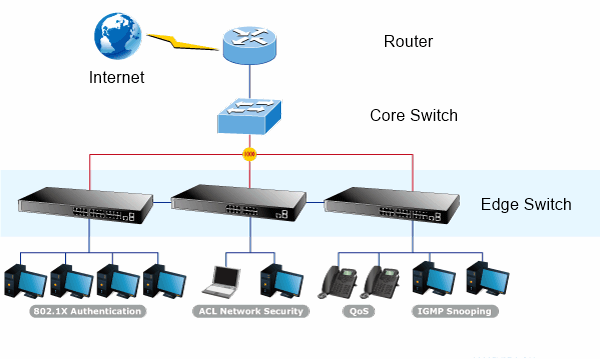Choosing a data switch for your network can be a daunting task, given the myriads of vendors out there who are vying for providing network switches with fancy functions and feature sets. It may get more challenging when deciding which core switch and edge switch to buy: you have to make sure the switch you get is up to date so it can take advantage of latest technologies, and allows you to squeeze every last drop of performance out of the system. So, whether to choose a core switch or edge switch? Let’s go through their functions and roles within a network, and link these with you are gonna achieve, then you may find the answer.

What Is a Core Switch?
A core switch is a high-capacity switch generally positioned within the backbone or physical core of a network. Core switch is also regarded as a backbone device that is vital to the successful operation of a network: it serves as the gateway to a wide area network (WAN) or the Internet, so that you can use it to connect to servers, your Internet service provider (ISP) via a router, and to aggregate all switches. A core switch need to be powerful enough and have significant capacity to handle the load sent to it, which means it should always be a fast, full-featured managed switch.
In a public WAN, a core switch interconnects edge switches that are positioned on the edges of related networks. In a local area network (LAN), this switch interconnects work group switches, which are relatively low-capacity switches that are usually positioned in geographic clusters.

How About an Edge Switch?
As the name indicates, an edge switch is a switch located at the meeting point of two networks. These switches connect end-user local area networks (LANs) to Internet service provider (ISP) networks. Referred to as access nodes or service nodes, an edge switch connects client devices, like laptops, desktops, security cameras, and wireless access points to your network. Edge switches for WANs are multiservice units supporting a wide variety of communication technologies, it also provides enhanced services such as virtual private networking support, VoIP and quality of service (QoS). Generally, smart switches and even unmanaged switches are valid options at the edge of your network. But for some downtime-sensitive applications or where security matters, a managed switch can also be equally used at the edge.
Core Switch/Edge Switch Selection: What Exactly Matters?
To select the appropriate switch for a layer in a particular network, you need to make clear specifications regarding current/future needs, target traffic flows and user communities.
1. Future Growth
Switches comes in different sizes, features and function, choosing a switch to match a particular network involves a solid network plan for any future growth. With that in mind, you would want to purchase a switch that can accommodate more than 24 ports, such as stackable or modular switches that can scale.
2. Performance
When selecting a switch for the access, distribution, or core layer, consider the ability of the switch to support the port density, forwarding rates, and bandwidth aggregation requirements of your network.
An edge switch needs to support features such as port security, VLANs, Fast Ethernet/Gigabit Ethernet, PoE and link aggregation. While a core switch also needs to support link aggregation to ensure adequate bandwidth coming into the core from the distribution layer switches. Also, a core switch support additional hardware redundancy features like redundant power supplies, and hot-swappable cooling fans. So there is no downtime during switch maintenance.
FS.COM Core Switch and Edge Switch Solution
FS.COM offers a large portfolio of Ethernet switches including 10GbE switch, 25GbE switch, 40GbE switch and 100GbE switch, each with different port configurations and moderate to advanced feature sets that tailored for enterprise networks and data centers. The core switch and edge switch in FS.COM are presented as follows.
| Core Switch | S5850-32S2Q, S5850-48T4Q, S5850-48S6Q, S5850-48S2Q4C, S8050-20Q4C, N5850-48S6Q, N8000-32Q, N8500-32C, N8500-48B6C |
| Edge Switch | S3700-24T4S, S2800-24T4F, S3800-24T4S, S3800-48T4S, S3800-24F4S, S5800-8TF12S, S5800-48F4S |
All these network switches are tested with the highest industry standard in rigorous environment, for more specifications, just reach out to us via sales@fs.com.

No comments:
Post a Comment